
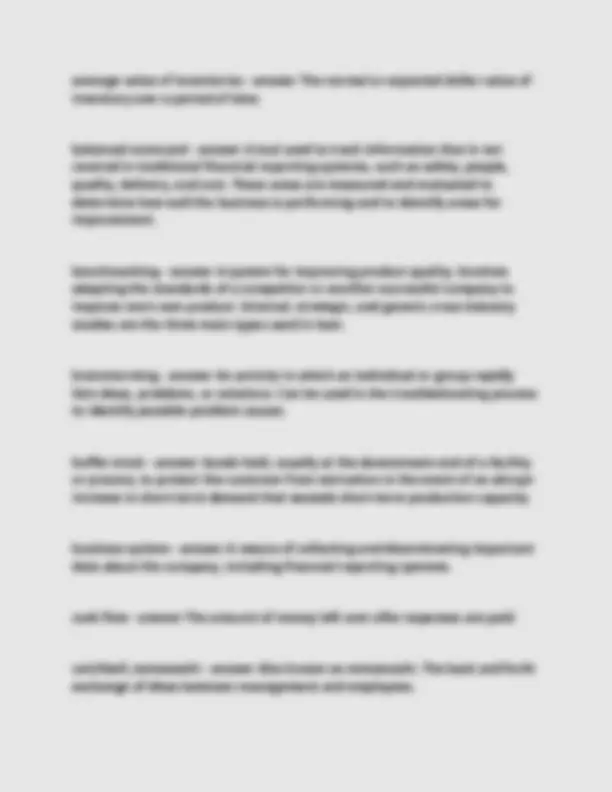
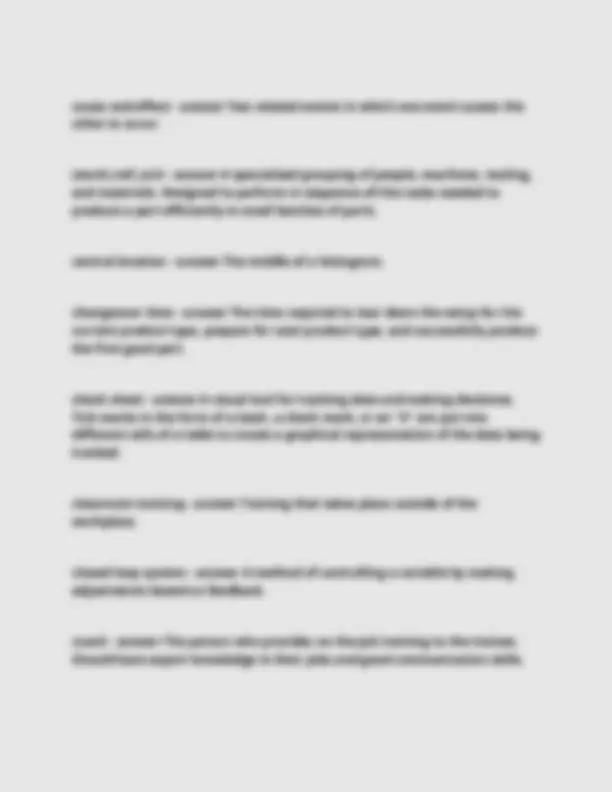
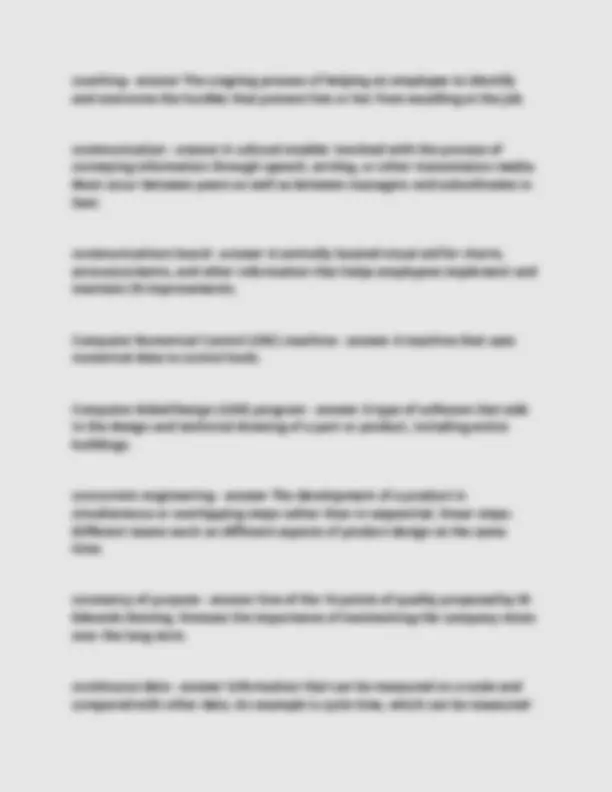
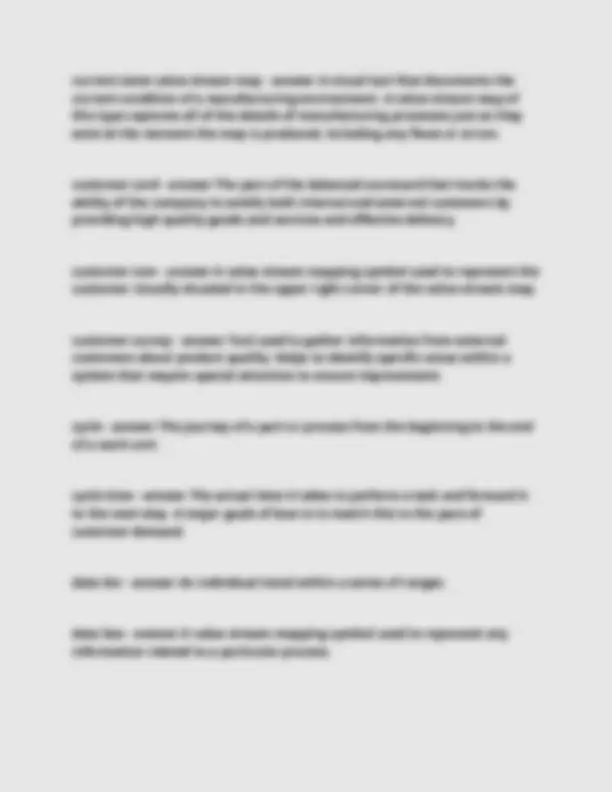
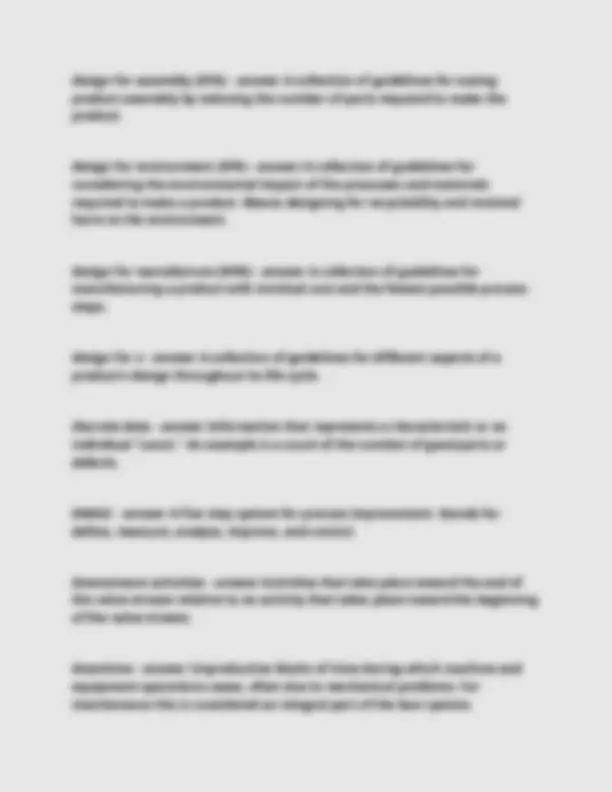
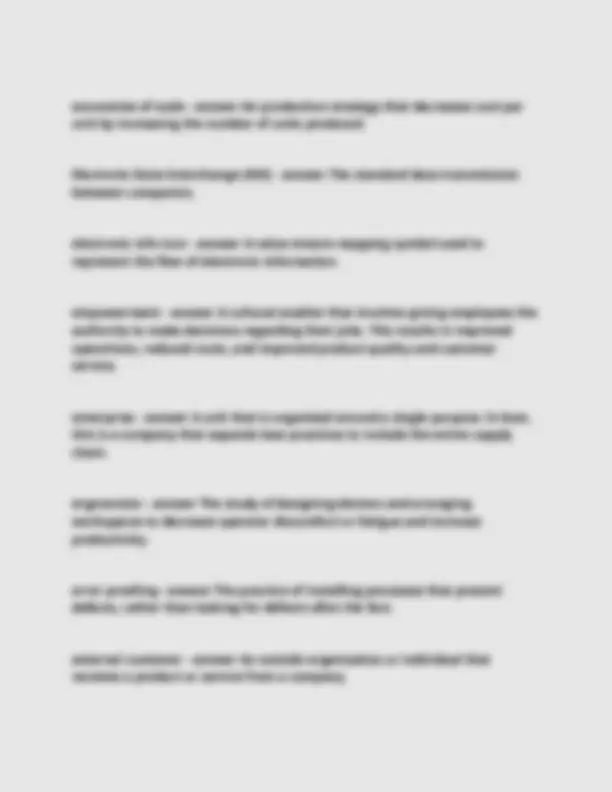
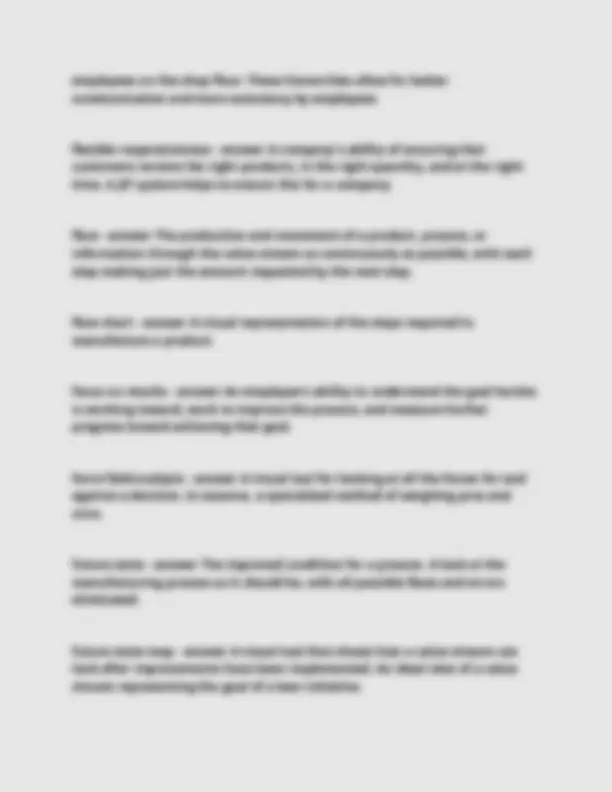
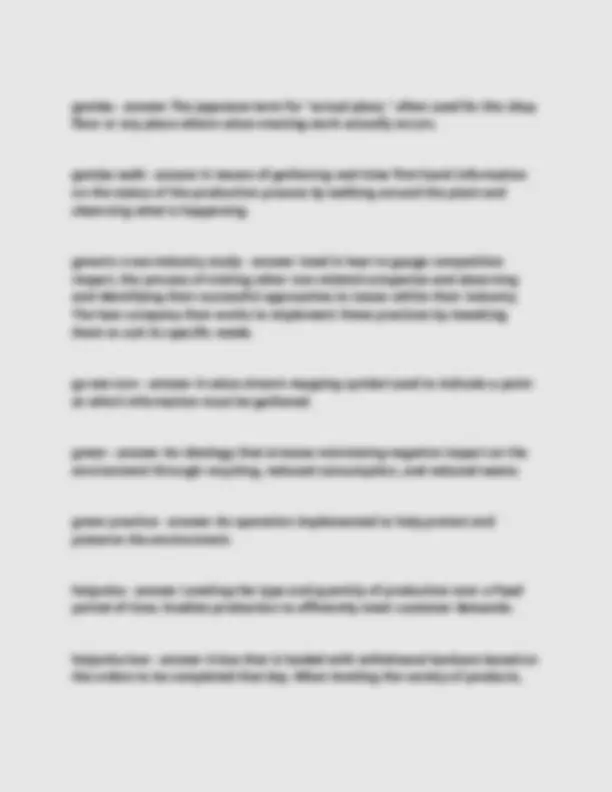
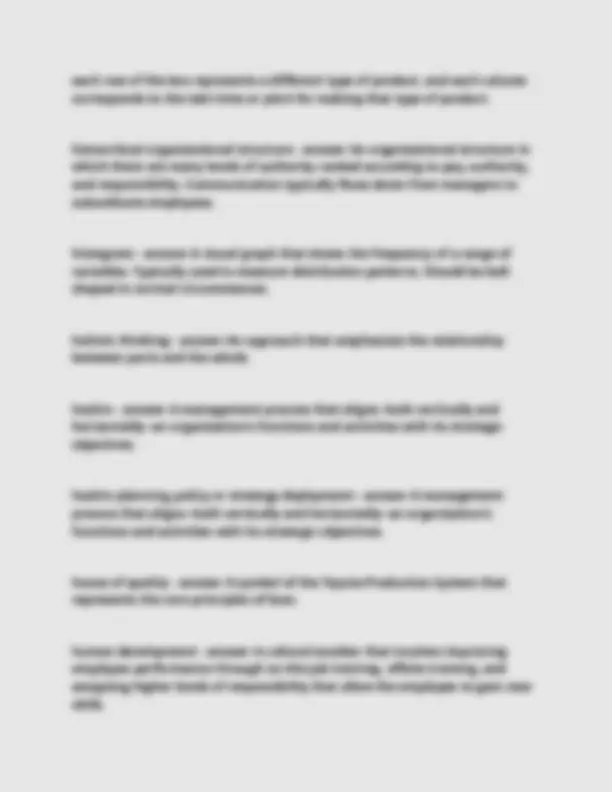
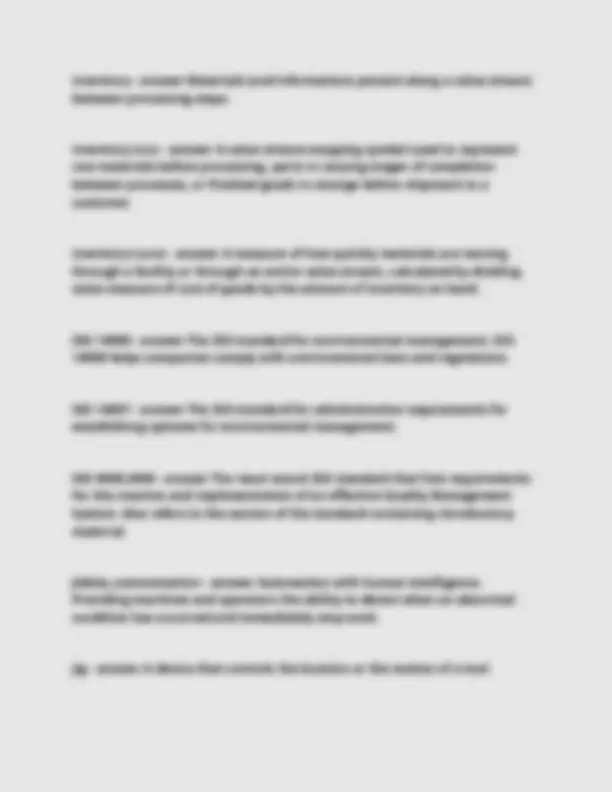
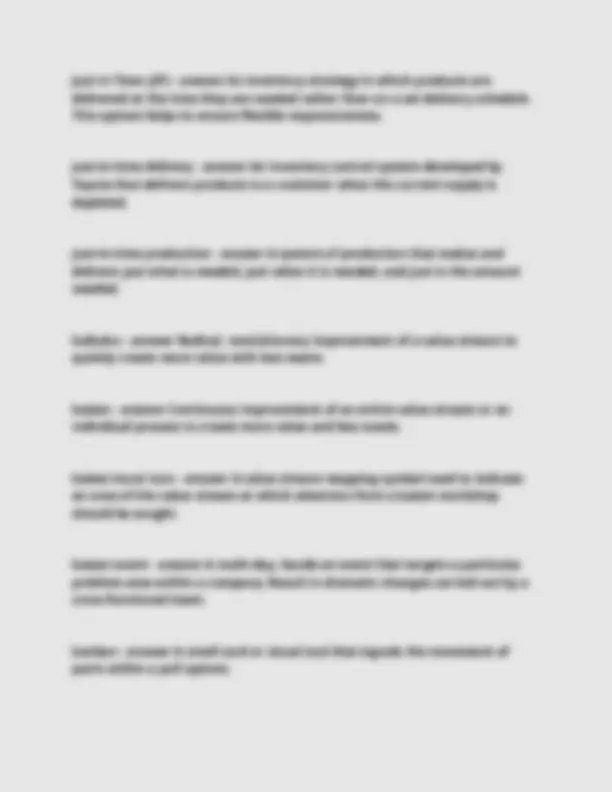
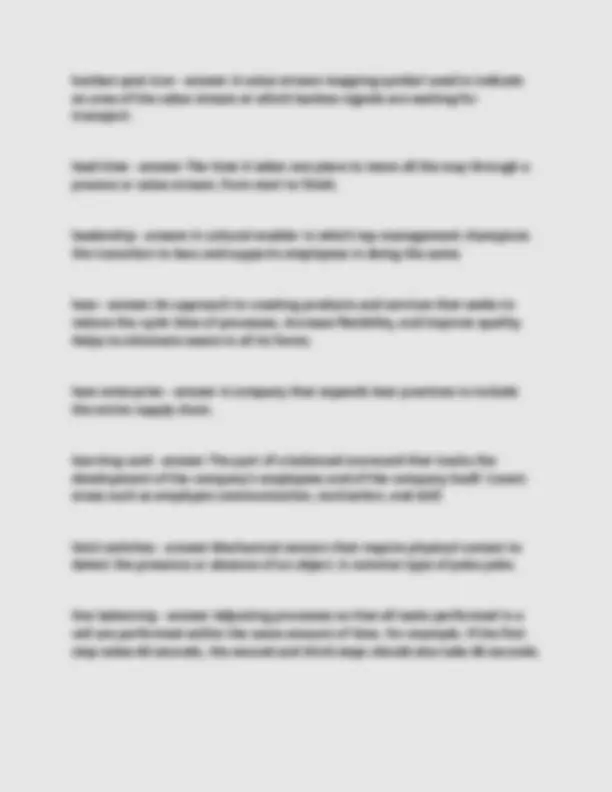
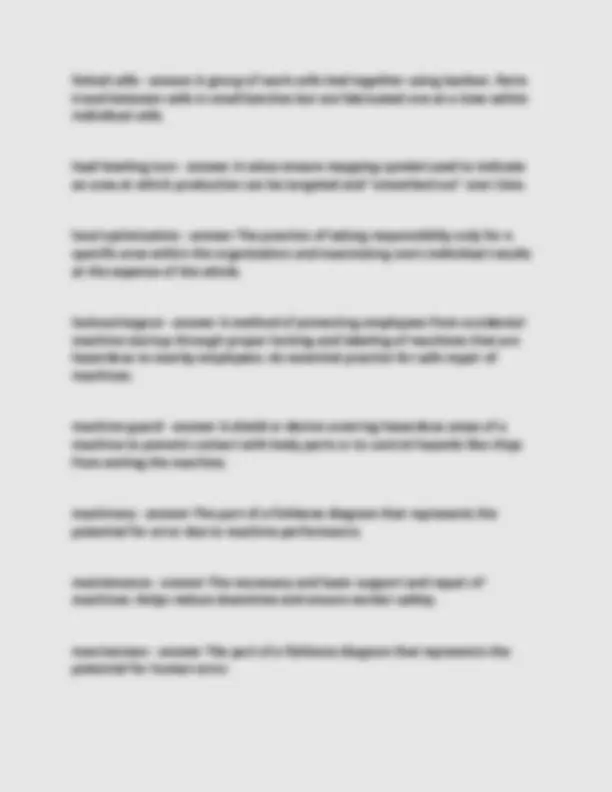
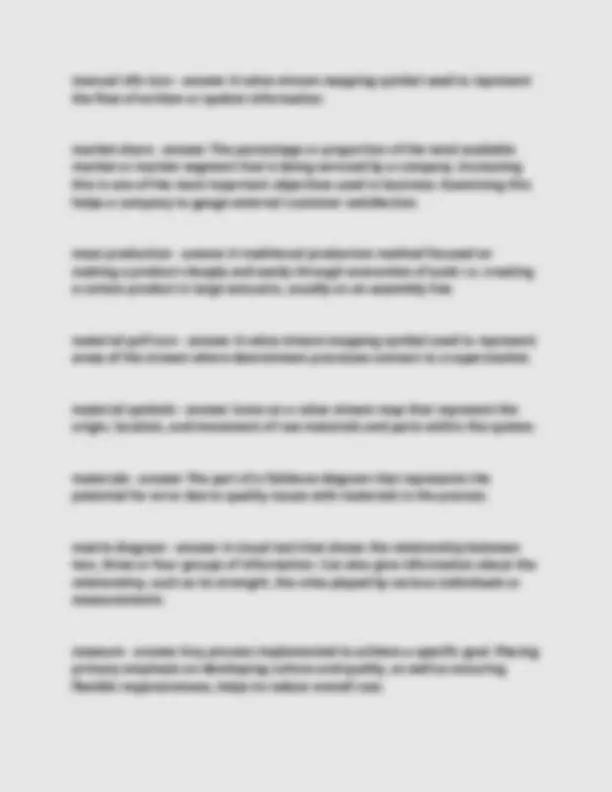
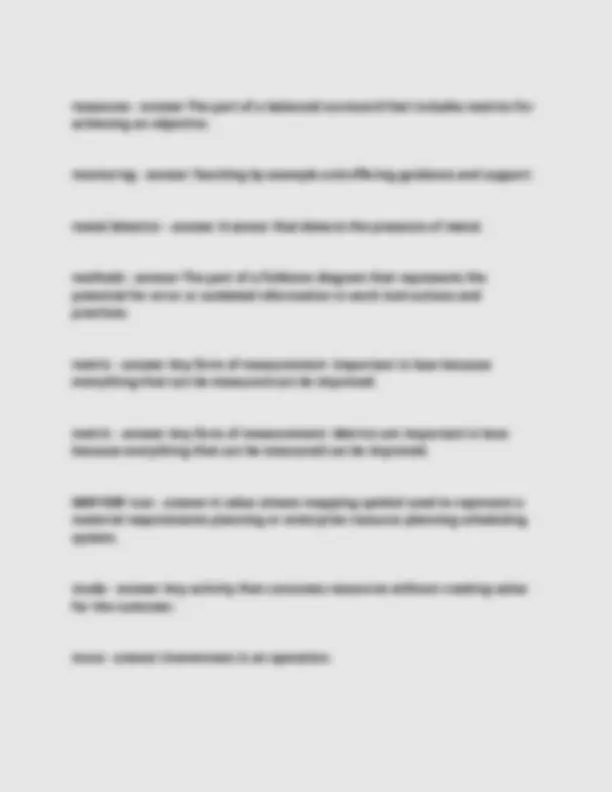
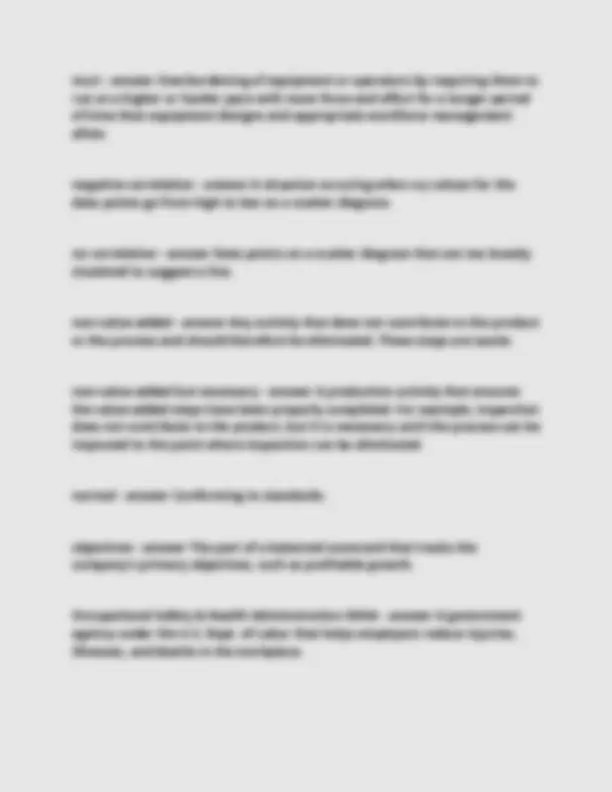
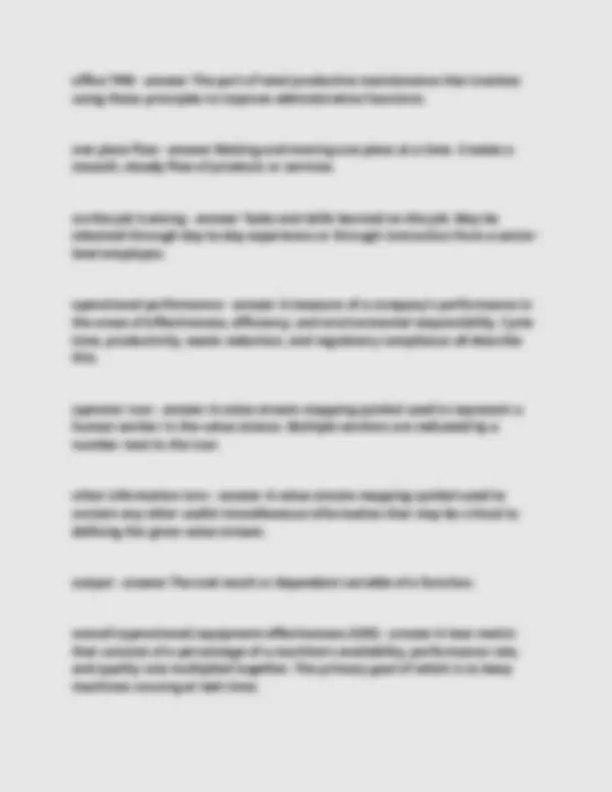
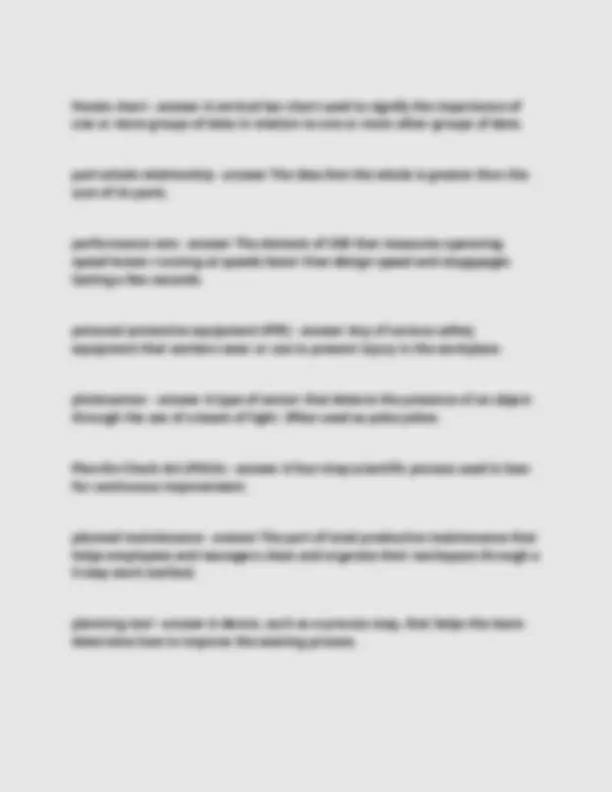
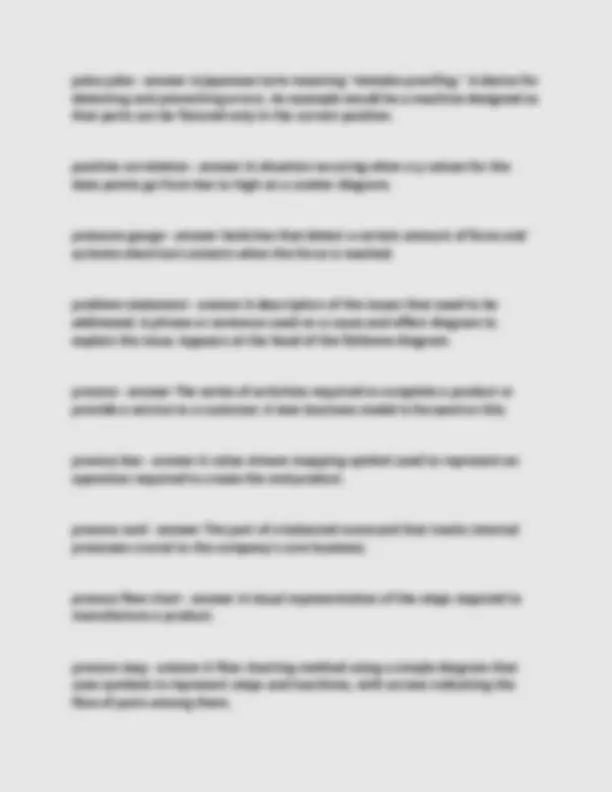
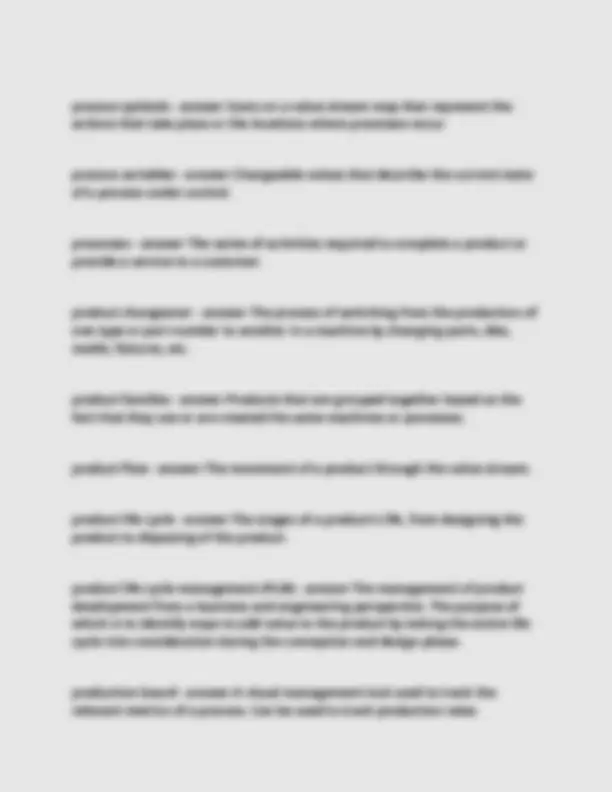
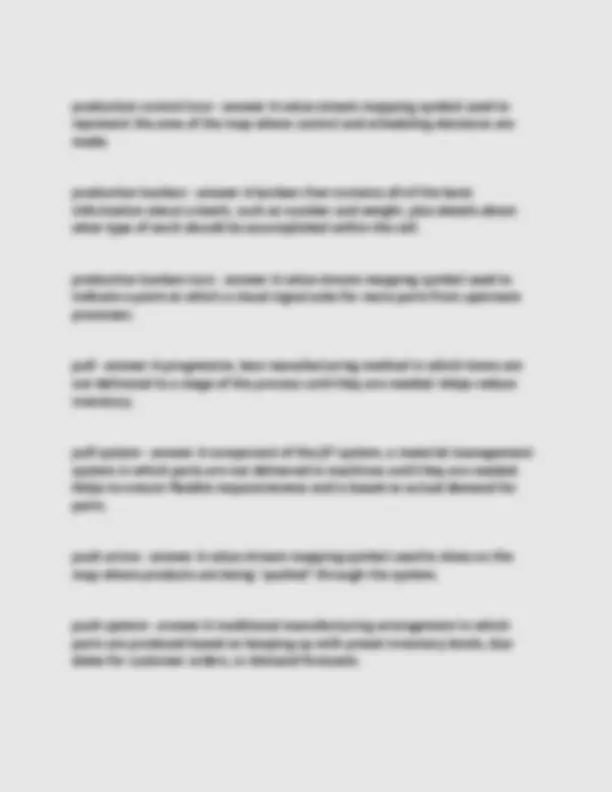
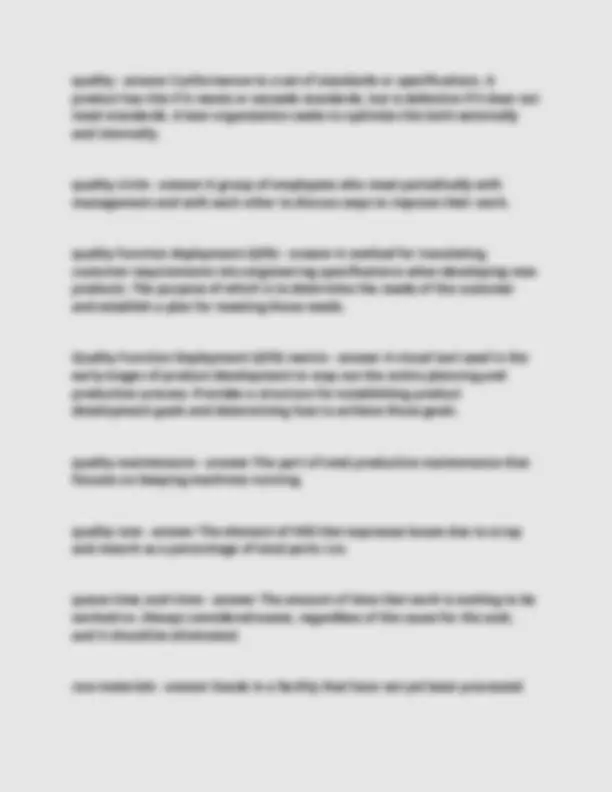
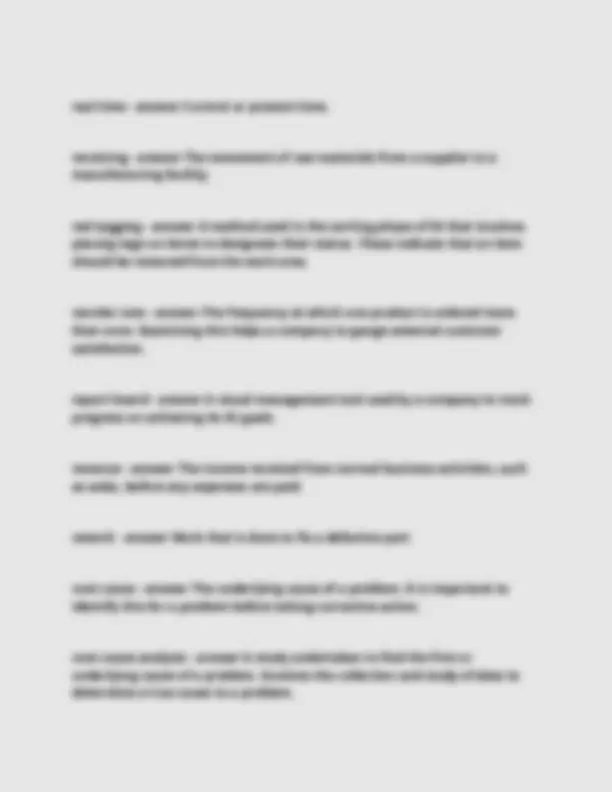
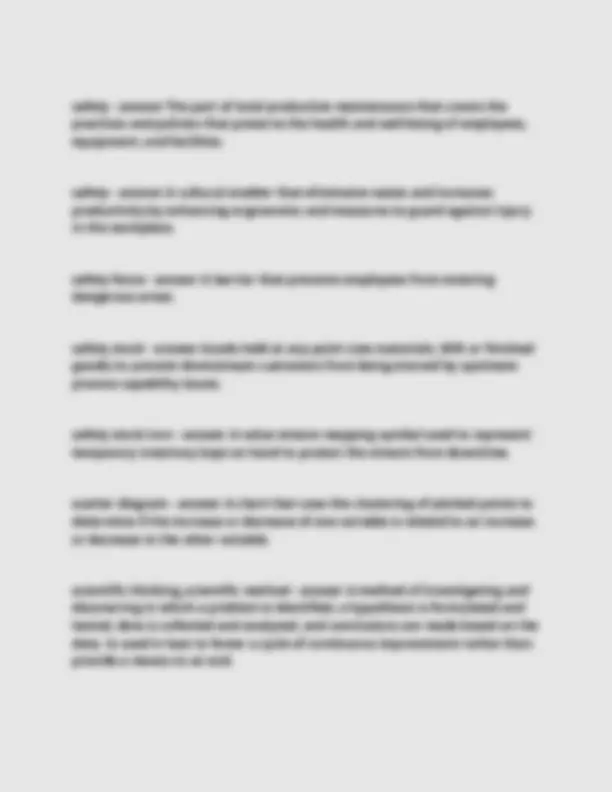
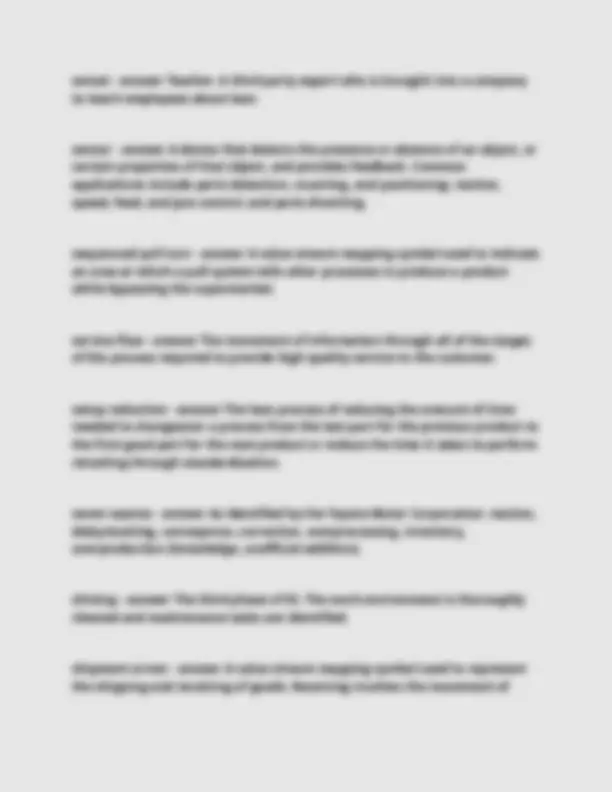
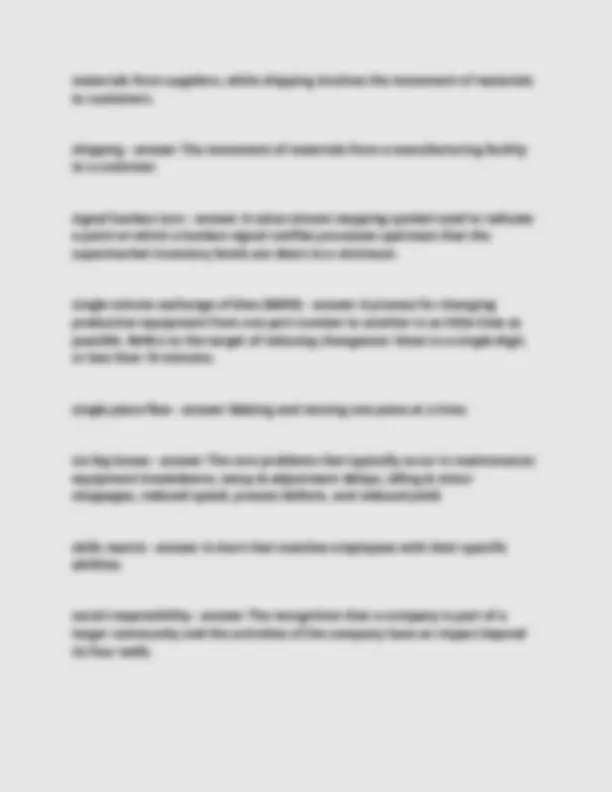
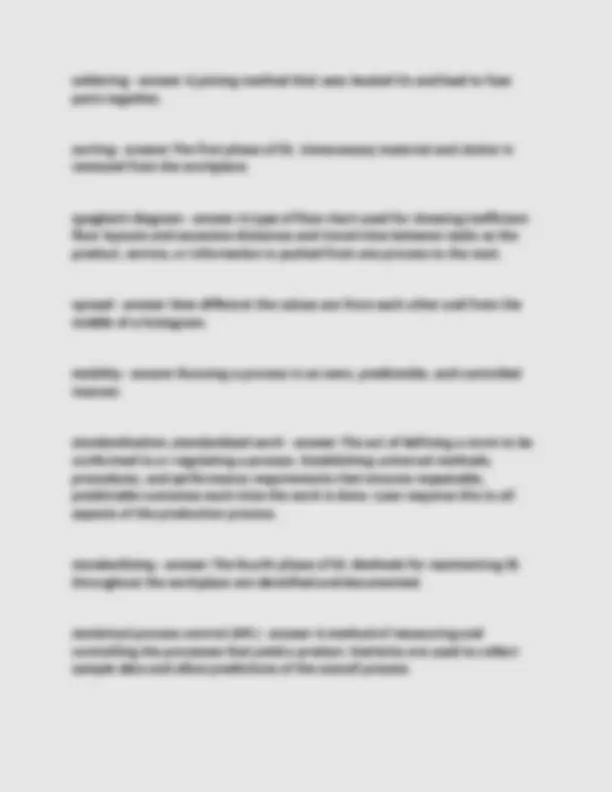
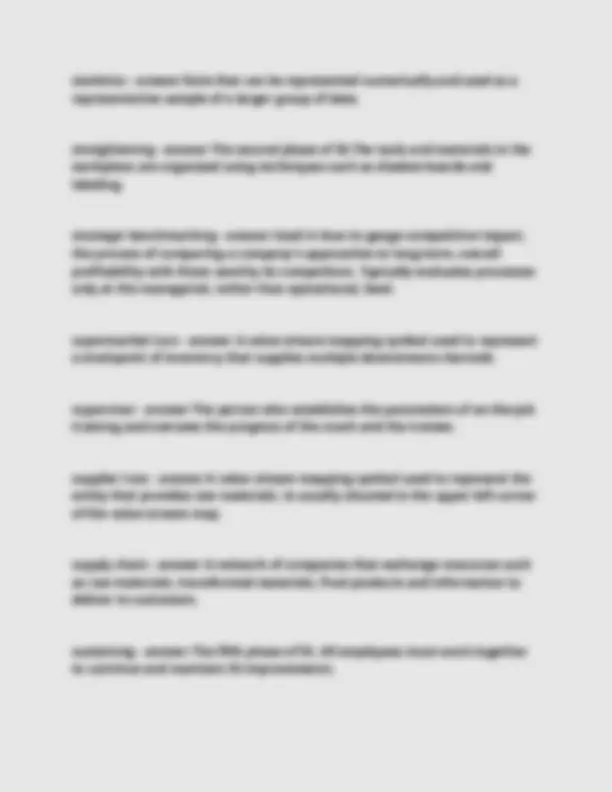
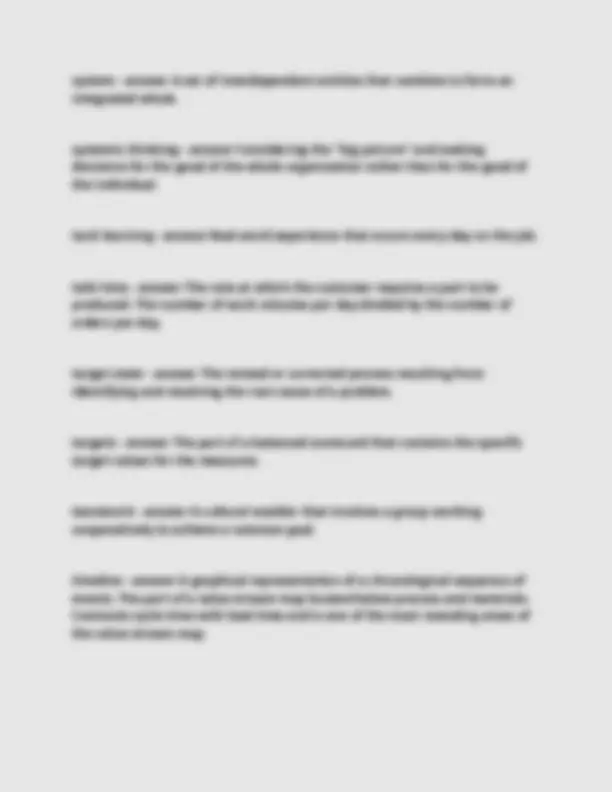
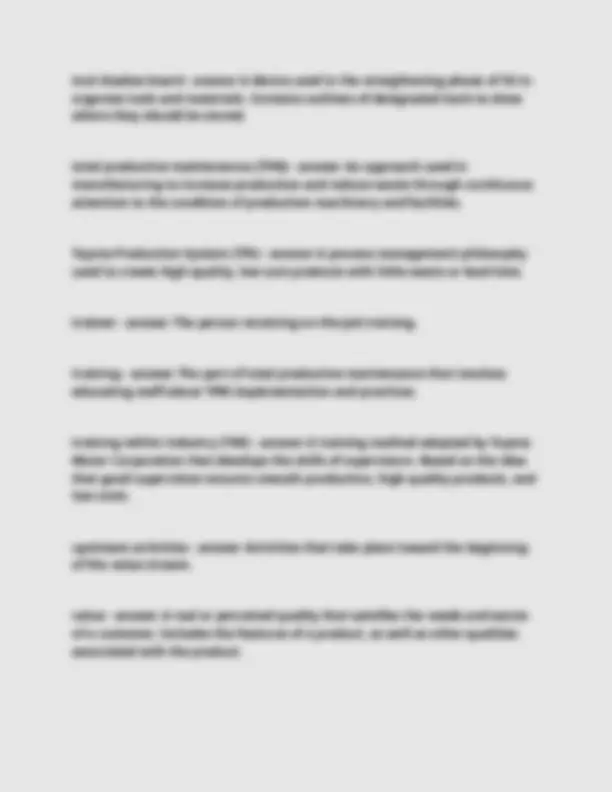
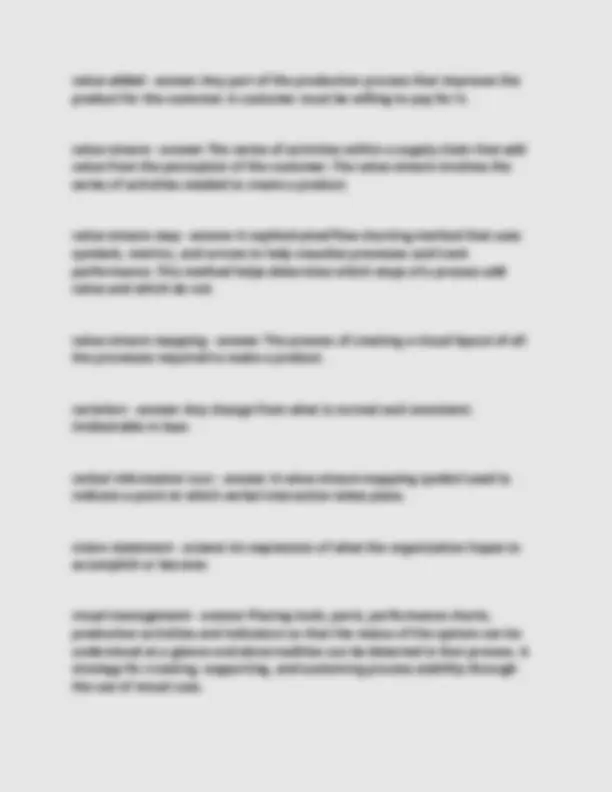



Study with the several resources on Docsity

Earn points by helping other students or get them with a premium plan


Prepare for your exams
Study with the several resources on Docsity

Earn points to download
Earn points by helping other students or get them with a premium plan
Community
Ask the community for help and clear up your study doubts
Discover the best universities in your country according to Docsity users
Free resources
Download our free guides on studying techniques, anxiety management strategies, and thesis advice from Docsity tutors
Lean Bronze Certification Vocabulary questions and answers.docx
Typology: Exams
1 / 40

This page cannot be seen from the preview
Don't miss anything!

































14 points of quality - answer An approach to total quality management developed by W. Edwards Deming. 4 Ms - answer An approach to stability developed by Toyota, man/woman, machine, material, and methods. 5S - answer A targeted list of activities that promotes workplace organization and efficiency in the workplace; sort, straighten, shine, standardize, and sustain. 80/20 rule_Pareto Principle - answer The belief that 80 percent of errors in a system are caused by only 20 percent of the inputs. Also known as the Pareto principle. A3 report - answer A Toyota-pioneered practice of getting the problem, analysis, corrective actions, and action plan down on a single sheet of large paper. abnormal - answer Deviating from standards.
affinity diagram - answer A tool used to organize different data or ideas into categories, sometimes used in brainstorming. American National Standards Institute - answer An organization that sets norms and conformance standards for products. andon - answer A visual management tool that highlights the status of operations in an area at a single glance and that signals whenever an abnormality occurs. annual cost of goods sold (COGS) - answer The total costs involved in making a product or service, usally includes labor and materials. assessment tool - answer A device or activity, such as a chart, report, or brainstorming session, that helps the kaizen team determine the state of the process either before or after the event. automatic stop - answer Ensuring that a production process stops whenever a problem or defect occurs. autonomous maintenance - answer The part of total productive maintenance that emphasizes operator involvement in machine maintenance. availability - answer The element of OEE that measures downtime losses from equipment failures and adjustments as a percentage of scheduled time. average - answer The statistical norm or expected value that falls within the middle of a distribution pattern.
cause and effect - answer Two related events in which one event causes the other to occur. (work) cell_unit - answer A specialized grouping of people, machines, tooling, and materials. Designed to perform in sequence all the tasks needed to produce a part efficiently in small batches of parts. central location - answer The middle of a histogram. changeover time - answer The time required to tear down the setup for the current product type, prepare for next product type, and successfully produce the first good part. check sheet - answer A visual tool for tracking data and making decisions. Tick marks in the form of a slash, a check mark, or an "X" are put into different cells of a table to create a graphical representation of the data being tracked. classroom training - answer Training that takes place outside of the workplace. closed-loop system - answer A method of controlling a variable by making adjustments based on feedback. coach - answer The person who provides on-the-job training to the trainee. Should have expert knowledge in their jobs and good communication skills.
coaching - answer The ongoing process of helping an employee to identify and overcome the hurdles that prevent him or her from excelling at the job. communication - answer A cultural enabler involved with the process of conveying information through speech, writing, or other transmission media. Must occur between peers as well as between managers and subordinates in lean. communications board - answer A centrally located visual aid for charts, announcements, and other information that helps employees implement and maintain 5S improvements. Computer Numerical Control (CNC) machine - answer A machine that uses numerical data to control tools. Computer-Aided Design (CAD) program - answer A type of software that aids in the design and technical drawing of a part or product, including entire buildings. concurrent engineering - answer The development of a product in simultaneous or overlapping steps rather than in sequential, linear steps. Different teams work on different aspects of product design at the same time. constancy of purpose - answer One of the 14 points of quality proposed by W. Edwards Deming. Stresses the importance of maintaining the company vision over the long term. continuous data - answer Information that can be measured on a scale and compared with other data. An example is cycle time, which can be measured
countermeasure - answer An action taken in response to another action. Kaizen events involve a cross-functional team that comes together for two to five days to work on a targeted problem area and implement these for the problem. critical to quality - answer Specific, measurable characteristics of a product or process that are identified by customers as necessary for their satisfaction. cross docking - answer The practice of unloading materials at a dock, matching them to outgoing shipment orders, and immediately loading the items to outgoing trucks or rail cars. Ideally, no items are left in stock for pick up at a later time. cross training - answer The process of teaching two or more people how to do each other's jobs. Results in greater job efficiency and a better quality product. cultural enabler - answer The policies and practices that establish and support the changes a company is trying to make. For transitioning to a lean culture these include: leadership, communication, development, teamwork, empowerment, and safety. culture - answer The values, beliefs, and habits that bind together a group of people and give them a sense of identity. In lean this develops people through educating employees, respecting and empowering individual employees, and providing employees with a healthy and safe work environment. current state - answer The current condition of a process.
current state value stream map - answer A visual tool that documents the current condition of a manufacturing environment. A value stream map of this type captures all of the details of manufacturing processes just as they exist at the moment the map is produced, including any flaws or errors. customer card - answer The part of the balanced scorecard that tracks the ability of the company to satisfy both internal and external customers by providing high quality goods and services and effective delivery. customer icon - answer A value stream mapping symbol used to represent the customer. Usually situated in the upper right corner of the value stream map. customer survey - answer Tool used to gather information from external customers about product quality. Helps to identify specific areas within a system that require special attention to ensure improvement. cycle - answer The journey of a part or process from the beginning to the end of a work unit. cycle time - answer The actual time it takes to perform a task and forward it to the next step. A major goals of lean is to match this to the pace of customer demand. data bin - answer An individual trend within a series of ranges. data box - answer A value stream mapping symbol used to represent any information related to a particular process.
economies of scale - answer An production strategy that decreases cost per unit by increasing the number of units produced. Electronic Data Interchange (EDI) - answer The standard data transmission between computers. electronic info icon - answer A value stream mapping symbol used to represent the flow of electronic information. empowerment - answer A cultural enabler that involves giving employees the authority to make decisions regarding their jobs. This results in improved operations, reduced costs, and improved product quality and customer service. enterprise - answer A unit that is organized around a single purpose. In lean, this is a company that expands lean practices to include the entire supply chain. ergonomics - answer The study of designing devices and arranging workspaces to decrease operator discomfort or fatigue and increase productivity. error proofing - answer The practice of installing processes that prevent defects, rather than looking for defects after the fact. external customer - answer An outside organization or individual that receives a product or service from a company.
external quality - answer The degree of satisfaction of external customers. Examining market share and reorder rates, as well as using quality function deployment, helps to measure and improve this. external shipment icon - answer A value stream mapping symbol used to represent shipments from suppliers or to customers. external step - answer A changeover step that can be achieved while a machine is still running. extrinsic motivation - answer The drive to act based on possible external rewards. These rewards might include financial or other incentives to reward ideas. failure modes and effects analysis (FMEA) - answer A document used to identify and assess potential failure modes in a product or process. Includes potential causes and effects of failure along with a prediction of the likelihood of their occurrence. feedback - answer Information sent back into the control system that allows actual performance to be compared to planned performance. FIFO lane icon - answer A value stream mapping symbol representing an inventory management method in which the oldest product, or first product, is processed first and thus is the first to come out of the system. financial card - answer The part of the balanced scorecard that covers financial information in a manner that it becomes an equal part of an integrated system. Also tracks information not found on a traditional report, such as risk assessment and cost-benefit data.
employees on the shop floor. These hierarchies allow for better communication and more automony by employees. flexible responsiveness - answer A company's ability of ensuring that customers receive the right products, in the right quantity, and at the right time. A JIT system helps to ensure this for a company. flow - answer The production and movement of a product, process, or information through the value stream as continuously as possible, with each step making just the amount requested by the next step. flow chart - answer A visual representation of the steps required to manufacture a product. focus on results - answer An employee's ability to understand the goal he/she is working toward, work to improve the process, and measure his/her progress toward achieving that goal. force field analysis - answer A visual tool for looking at all the forces for and against a decision. In essence, a specialized method of weighing pros and cons. future state - answer The improved condition for a process. A look at the manufacturing process as it should be, with all possible flaws and errors eliminated. future state map - answer A visual tool that shows how a value stream can look after improvements have been implemented. An ideal view of a value stream representing the goal of a lean initiative.
gemba - answer The Japanese term for "actual place," often used for the shop floor or any place where value-creating work actually occurs. gemba walk - answer A means of gathering real-time first-hand information on the status of the production process by walking around the plant and observing what is happening. generic cross-industry study - answer Used in lean to gauge competitive impact, the process of visiting other non-related companies and observing and identifying their successful approaches to issues within their industry. The lean company then works to implement these practices by tweaking them to suit its specific needs. go see icon - answer A value stream mapping symbol used to indicate a point at which information must be gathered. green - answer An ideology that stresses minimizing negative impact on the environment through recycling, reduced consumption, and reduced waste. green practice - answer An operation implemented to help protect and preserve the environment. heijunka - answer Leveling the type and quantity of production over a fixed period of time. Enables production to efficiently meet customer demands. heijunka box - answer A box that is loaded with withdrawal kanbans based on the orders to be completed that day. When leveling the variety of products,
humility - answer A person's ability to admit that he or she does not know everything, and that someone else's idea might be better. Allows people to keep an open mind and increases their opportunities for learning. icon - answer An image or picture used to signify an object or process. idea system - answer A process used in lean in which employees notify management of problems and opportunities for improvement and recommend solutions. A key means of empowering employees. ideal state - answer A type of value stream map that shows what the value stream would look like after all known lean methods have been incorporated. Identifies opportunities for improvement in the value stream. implementation plan - answer A document that sets the limits within which the process should operate. This tool lists specific process activities and then states the variables or risks affecting them, as well as their specifications. information symbols - answer Icons on a value stream map that represent the form, flow, and direction of communication and data. infrastructure - answer The foundation or supporting elements of an entity. initiatives - answer The part of a balanced scorecard that includes actions that must be taken in order to meet the objective. input - answer The value or independent variable entered into a function.
internal benchmarking - answer Used in lean to gauge competitive impact, the process of comparing processes from within a company. By providing data about each individual process, a company can see which processes are yielding optimal results and apply these attributes to other processes. internal customer - answer Departments or employees within a company that rely on the products, services, or other forms of cooperation from other departments or employees in the company. internal quality - answer The degree of satisfaction of internal customers. Examining value- and non-value-added steps, as well as measuring cycle time, helps to measure and improve this. internal step - answer An operation that can and must be performed only when the machine is out of service. International Organization for Standardization - answer An organization based in Switzerland that develops and publishes standards for its international membership base. interrelationship diagram - answer A visual tool that helps a team identify the cause-and-effect relationships among critical issues. Distinguishes between issues that serve as causes and those that are outcomes. intrinsic motivation - answer The drive to act based on possible personal factors. Includes recognition by peers, the opportunity to contribute to a broader company goal, and the personal growth that stems from development of leadership skills.
Just in Time (JIT) - answer An inventory strategy in which products are delivered at the time they are needed rather than on a set delivery schedule. This system helps to ensure flexible responsiveness. just-in-time delivery - answer An inventory control system developed by Toyota that delivers products to a customer when the current supply is depleted. just-in-time production - answer A system of production that makes and delivers just what is needed, just when it is needed, and just in the amount needed. kaikaku - answer Radical, revolutionary improvement of a value stream to quickly create more value with less waste. kaizen - answer Continuous improvement of an entire value stream or an individual process to create more value and less waste. kaizen burst icon - answer A value stream mapping symbol used to indicate an area of the value stream at which attention from a kaizen workshop should be sought. kaizen event - answer A multi-day, hands-on event that targets a particular problem area within a company. Result in dramatic changes carried out by a cross-functional team. kanban - answer A small card or visual tool that signals the movement of parts within a pull system.
kanban post icon - answer A value stream mapping symbol used to indicate an area of the value stream at which kanban signals are waiting for transport. lead time - answer The time it takes one piece to move all the way through a process or value stream, from start to finish. leadership - answer A cultural enabler in which top management champions the transition to lean and supports employees in doing the same. lean - answer An approach to creating products and services that seeks to reduce the cycle time of processes, increase flexibility, and improve quality. Helps to eliminate waste in all its forms. lean enterprise - answer A company that expands lean practices to include the entire supply chain. learning card - answer The part of a balanced scorecard that tracks the development of the company's employees and of the company itself. Covers areas such as employee communication, motivation, and skill. limit switches - answer Mechanical sensors that require physical contact to detect the presence or absence of an object. A common type of poka yoke. line balancing - answer Adjusting processes so that all tasks performed in a cell are performed within the same amount of time. For example, if the first step takes 60 seconds, the second and third steps should also take 60 seconds.